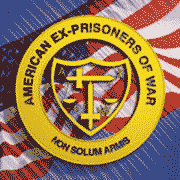
Established April 14, 1942
 |
American Ex-Prisoners of War
A not-for-profit, Congressionally-chartered veterans’ service organization advocating for former prisoners of war and their families.
Established April 14, 1942 |

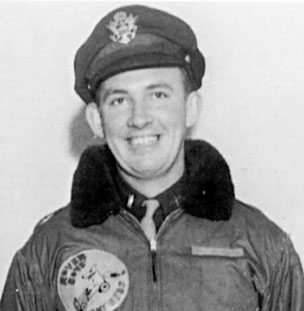
"Hap" In Lincoln, NE, Oct. 1944
|

"Hap's" 77th Birthday, Feb. 4, 1999
|
|
| Last Name | First Name, Middle Init. | Nickname |
| Street Add. | City | State |
| Zip | Spouse | |
| Conflict | Branch of Service | Unit: |
| Theatre of Operation | Military Job | Where Captured |
| Date Captured | Time Interned | Camps |
| Date Liberated | Medals Received | Age at Capture |
| After the War ... | ||
After completion of B-29 training Hap and a crew of 11, called "Rover Boys Express", spent time in Lincoln, Nebraska, then Herington, KS where they received their own B-29. Orders were to fly their new B-29 west alone to Mather Field, CA, then across the Pacific alone to John Rogers Field, Hawaii, then to Kwajalein Island; then to Saipan where the 73rd Wing Base was located; they were to fly combat missions to bomb and destroy Japanese mainland targets.
They flew missions to Iwo Jima, Nagoya, Kobe/Akashi in December 1944 and January 1945 and were shot down on their fourth mission—target #357 Nakajima Aircraft Factory, Tokyo. They were eastbound at 32,000 ft. passing Mt. Fuji when shot down over Tokyo by a Japanese Twin Engine Toryu (Nick) Fighter that came in from 1 o'clock high. Three engines were on fire. The crew had to parachute into Tokyo when the fighter blew out the nose, the 70o+ temperature in their pressurized B-29 dropped instantly to 58o below zero.
Hap fell free from 27,000 ft. to approximately 3,000 ft. before opening his chute and landing in N.E. Tokyo. He was set upon immediately by civilians, and severe beatings followed. Mr. Halloran was near death when Japanese soldiers (MPs from Kempei Lao Secret Service Torture Prison) seized him from civilians and took him to Kempei Tai Torture Main Prison in Tokyo, adjacent the moat at the north edge of the Imperial Palace grounds. Hap spent 67 days in solitary confinement in a cold, dark cage. Beatings and brutal interrogations followed. Hap lived through the March 10, 1945 fire raid on Tokyo were over 100,000 were killed by B-29s bombing from 0100 to 0400 a.m. The heat, smoke and firestorm were absolutely terrifying.
Then Hap was moved to Ueno Zoo in Tokyo where he was a prisoner in animal cage and tied to the front bars in his lion cage so civilians could march by and view a B-29 flyer. He was naked and black from lack of washing with hair all over his face. Hap lost 90 lbs. and was covered with open running sores from flea andbed bug bites. He spent April 1, 1945 to August 1945 in Omori POW Camp contiguous SW Tokyo. Pappy Boyington, a friend of his was also in his barracks. Bombings and strafings by American B-29s and navy/marine fighters were constant on their unmarked prison barracks. 'Hap' wrote and delivered the eulogy for Boyington 1-15-88 at Arlington National Cemetery.
On 8-29-45 Hap and others were liberated by Marine/Navy landing forces and taken aboard the hospital ship Benevolence in Tokyo Bay. Hap spent about a year in a hospital at Ashford General Hospital, in White Sulphur Springs, W.VA. He left the service in September 1946. 'Hap' was near the Battleship Missouri when the Peace Treaty was signed on September 2nd, 1945
Hap experienced 39 years of nightmares after his ordeal. He later returned to Tokyo in 1984-85, 1989 and 1995, were he met Ambassador Mike Mansfield who was a great help. Hap was also reunited with a former guard (friendly) and many others including: Kaneyuki Kobayashi, former guard, Saburo Sakai, leading living Japanese fighter ace (now friend) and Isamu Kashiide, who shot down their B-29 over Tokyo on 1-27-45 and many others. Reconciliation and friendship fianlly eradicated the nightmares of 39 years.
After leaving service in September 1946 Hap went into the transportation business. He joined Consolidated Freightways, a major transportation company in 1958 and held various executive positions and was member of Board of Directors and Executive Vice President. He is associated with Consolidated Freightways as Senior Vice President Emeritus in Corporate Headquarters, Meno Park, CA.; his 41st year with CF.
He raised three children and has two grandchildren. He resides in Menlo Park, CA. Hap has traveled extensively and has done TV shows on NBC, CBS, ABC, FOX, History, Discovery, C-Span, TLC cables and been a speaker/lecturer aboard cruise ships, military bases, classrooms, etc. 'Hap' and his son Dan, visited Honolulu, Guam, Saipan, Tinnian, and Tokyo in May 1999.
In 1998, Hap published a memoir, Hap's War subtitled "The Incredible Survival Story of a WWII Prisoner of War Slated for Execution." It is available at Amazon.com.
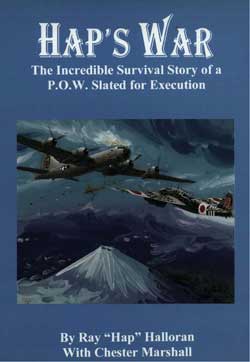
Hap's War
The Incredible Survival Story of a WWII Prisoner of War Slated for Execution |
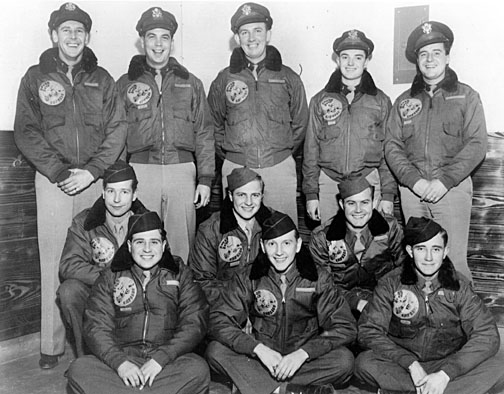
World War II B-29 Bomber Crew, "The Rover Boys Express." Photo taken at Lincoln, Nebraska, Oct. 1944, prior to departure for combat base on the Island of Saipan in The Marianas, 1,500 miles SSE of Tokyo
|
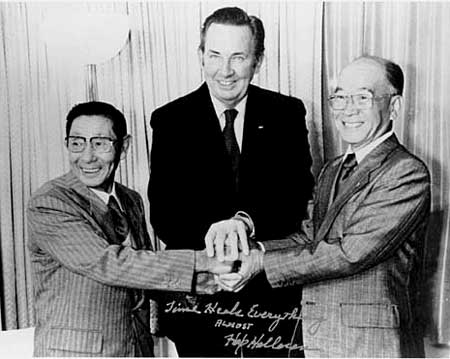
Left: Isamu Kashide, Japanese ace fighter pilot who shot down Hap's B-29 over Tokyo on January 27, 1945; right: Saburo Sakai leading living Japanese WWII ace. Center: Ray "Hap" Halloran. Photo taken at US Embassy, Tokyo, Sept. 1984.
|